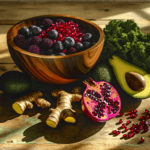Easy-to-Follow Home-Grown Fruit Guide for 2024
As we usher in 2024, the trend of home gardening has never been more popular. With sustainability and self-sufficiency becoming increasingly vital, more people are turning their backyards into lush, productive oases. Growing your own fruit not only provides you with fresh, organic produce but also offers a rewarding and therapeutic experience. Welcome to the "Easy-to-Follow Home-Grown Fruit Guide for 2024" where we delve into the essentials of cultivating your own fruit garden, even if you're a complete novice.
Introduction to Home-Grown Fruit Gardening
In the digital age, where fresh produce can be delivered to your doorstep with a click, why would anyone opt to grow their own fruit? The answer lies in the unparalleled taste, nutritional value, and the sheer satisfaction of biting into a fruit grown by your own hands. Moreover, home-grown fruits are free from harmful pesticides and chemicals, making them a healthier choice for you and your family.
Our "Home-Grown Fruit Guide 2024" aims to equip you with the knowledge and confidence to start your own fruit garden. Whether you have a sprawling backyard or a small balcony, there's a fruit gardening solution for you. This guide will walk you through selecting the right fruits, preparing your garden, and maintaining your plants for a bountiful harvest.
Why Grow Your Own Fruit in 2024?
Health Benefits
Freshly picked fruits are packed with nutrients, antioxidants, and fibers that are often lost in transit or during long storage periods. Home-grown fruits ensure you have access to the freshest produce possible.
Environmental Impact
By growing your own fruit, you reduce the carbon footprint associated with transporting store-bought produce. You also contribute to biodiversity by creating a habitat for pollinators like bees and butterflies.
Cost-Effectiveness
While the initial setup might require an investment, the long-term savings are substantial. Fruits like strawberries, apples, and berries can provide abundant yields for years.
Therapeutic Experience
Gardening is known to reduce stress and improve mental health. The act of nurturing plants and watching them grow can be incredibly fulfilling.
Choosing the Right Fruits for Your Garden
Consider Your Climate
The first step in our Home-Grown Fruit Guide 2024 is understanding your climate. Different fruits thrive in different conditions. Consider the USDA plant hardiness zone you live in to determine which fruits are best suited for your region.
Space Availability
Whether you have an extensive garden or a small patio, you can grow fruit. Container-friendly fruits like strawberries and dwarf citrus trees are ideal for limited spaces, while larger gardens can accommodate apple trees and grapevines.
Time and Commitment
Some fruits require more attention and care than others. Consider how much time you can realistically dedicate to your garden when choosing your plants.
Popular Fruits to Grow in 2024
- Strawberries: These perennials are perfect for beginners. They can be grown in containers or garden beds and provide a delicious yield.
- Blueberries: Known for their health benefits, blueberries require acidic soil but are otherwise low-maintenance.
- Apples: With hundreds of varieties, apple trees can be grown in most climates and are a staple in many home gardens.
- Citrus Fruits: Lemons and oranges can be grown indoors or outdoors in warm climates, adding a zest to your garden and kitchen.
- Grapes: Ideal for making jams, jellies, and wines, grapevines require a bit more space but are worth the effort.
Preparing Your Garden
Soil Preparation
Healthy soil is the foundation of a successful fruit garden. Conduct a soil test to determine its pH and nutrient levels. Most fruits prefer slightly acidic to neutral soil (pH 6-7). Amend your soil with organic matter like compost or well-rotted manure to improve its fertility and drainage.
Planting Techniques
- Container Gardening: This is ideal for small spaces. Ensure your containers have good drainage and use a quality potting mix.
- Raised Beds: These provide excellent drainage and can be filled with nutrient-rich soil, offering a controlled environment for your plants.
- Traditional Ground Planting: Suitable for larger spaces, this method allows for natural root development and is cost-effective.
Watering and Irrigation
Consistent watering is crucial for fruit plants, especially during the growing season. Consider installing drip irrigation systems for efficient water use, or establish a regular watering schedule to keep your plants hydrated.
Maintaining Your Fruit Garden
Fertilization
Fruits are heavy feeders and require regular nutrients. Use a balanced, organic fertilizer to feed your plants throughout the growing season. Follow the specific requirements for each type of fruit.
Pruning
Pruning is essential for maximizing fruit production and maintaining plant health. Remove dead or diseased branches and thin out crowded areas to improve air circulation.
Pest and Disease Control
Monitor your plants regularly for signs of pests or diseases. Use organic pesticides and natural remedies like neem oil to protect your plants without harming beneficial insects.
Pollination
Ensure your plants are adequately pollinated. Encourage bees and other pollinators by planting a variety of flowers and maintaining a pesticide-free garden.
Harvesting Your Fruits
Knowing When to Harvest
The key to delicious home-grown fruit is harvesting at the right time. Each fruit has specific indicators of ripeness. For example, apples should be firm, while strawberries should be fully red.
Harvesting Techniques
Use clean, sharp tools to harvest your fruits to prevent damage to the plants. Handle fruits gently to avoid bruising.
Post-Harvest Care
Proper storage extends the shelf life of your fruits. Some fruits like apples can be stored for months in a cool, dark place, while others like berries should be consumed or preserved shortly after harvest.
Advanced Tips for the Enthusiastic Gardener
Companion Planting
Certain plants can benefit from being grown together. For example, planting marigolds with strawberries can deter pests.
Extending the Growing Season
Use greenhouses or cold frames to extend your growing season, allowing you to enjoy fresh fruit even in cooler months.
Experiment with Varieties
Try growing heirloom or less common fruit varieties to add diversity and flavor to your garden.
Common Challenges and Solutions
Dealing with Limited Space
Vertical gardening techniques, such as trellises for climbing plants like grapes, can help maximize space.
Overcoming Poor Soil Quality
Raised beds or container gardening with high-quality potting soil can overcome poor native soil conditions.
Managing Time Constraints
Choose low-maintenance fruits if you have a busy schedule, and consider automating watering systems.
Conclusion
Embarking on the journey of home-grown fruit gardening in 2024 is both an exciting and rewarding endeavor. With the right guidance from our "Home-Grown Fruit Guide 2024", you can transform any space into a fruitful paradise. Remember, the key to success lies in preparation, patience, and a willingness to learn. Whether you're enjoying a fresh apple right from the tree or a handful of sweet strawberries, the taste of home-grown fruit is incomparable. Happy gardening!










